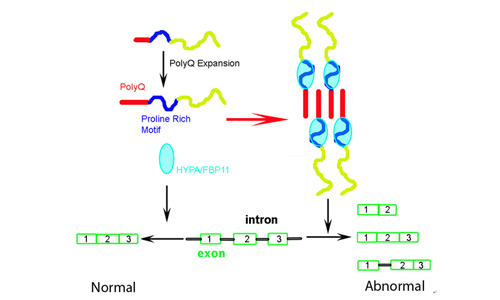Abnormal Interaction with PolyQ Expanded Huntingtin Alters Cellular Distribution and RNA Processing of HYPA
Source:
Time: 2011-07-19
Huntington’s disease (HD) is a dominant inherited disorder caused by the expansion of polyglutamine (polyQ) in exon 1 of the huntingtin (Htt) protein. Numerous proteins have been reported to interact with Htt. These Htt-interacting proteins are engaged in transcription, trafficking, endocytosis, signaling transduction and metabolism, in which many proteins interact with Htt through the PRR region. The PRR region of Htt was previously elucidated to interact with the SH3 or WW domain proteins (Gao-YG, et al., Structure, 2006, 14: 1755-1765), among which HYPA, a WW domain-containing protein, is an mRNA splicing factor. However, how the expanded polyQ tract influences the interaction of Htt with HYPA and consequently impacts on the cellular function of HYPA are largely unknown. Recently, a team of researchers, led by Dr. HU Hongyu, at the Institute of Biochemistry and Cell Biology, Shanghai Institutes for Biological Sciences, CAS, provided structural basis and biological consequence of this abnormal Htt interaction.
To directly investigate this abnormal interaction, JIANG Yajun and his colleagues used both NMR structural and biochemical methods. The PRR motif of Htt cooperatively interacts with the tandem WW domains of HYPA through domain-chaperoning effect of WW1 on WW2. The polyQ expanded Htt sequesters HYPA to the cytosolic location and then significantly reduces the efficiency of pre-mRNA splicing. They proposed that toxic gain-of-function of the mutant Htt that interferences with cellular RNA processing might be an alternative pathogenesis for HD.
This work entitled “Interaction with Polyglutamine Expanded Huntingtin Alters Cellular Distribution and RNA Processing of Huntingtin Yeast Two-hybrid Protein A (HYPA)” was published in The Journal of Biological Chemistry on July 15th, 2011.
This study was supported by the grants from the Chinese Academy of Sciences, the Ministry of Science and Technology, National Natural Science Foundation of China. (SIBCB)
AUTHOR CONTACT:
HU Hongyu
Institute of Biochemistry and Cell Biology, Shanghai Institutes for Biological Sciences, Chinese Academy of Sciences
Shanghai, China
Schematic Representation for the Toxic Gain-of-Function of PolyQ Expanded Htt. PolyQ expansion leads to both the conformational change of proline-rich motif and the aggregation of Htt. These structural and biochemical changes result in enhanced interaction of Htt with HYPA and thus sequestration of HYPA in cytosol. The decrease of functional HYPA in nucleus may cause abnormal function of HYPA in pre-mRNA splicing. (Graph provided by Dr. HU Hongyu).

 Appendix:
Appendix: